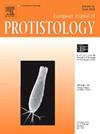真核细胞的典型和非典型细胞分裂与潜在减数分裂和性别
IF 1.6
2区 生物学
Q4 MICROBIOLOGY
引用次数: 0
摘要
真核体通常通过核内正丝分裂和纵向细胞分裂进行无性繁殖。核分裂时不溶解核膜,纺锤体呈径向对称。典型的纵向细胞分裂始于细胞前端的贮液区,分裂细胞的形状由“Y”形逐渐变为“V”形。本文综述了真核细胞中典型的有丝分裂和细胞质分裂,以及非典型细胞分裂,其中单个细胞产生两个以上的子细胞,形成独特的星形结构。在特定的应激条件下,如暴露于化学物质(如苯酚和二甲苯)和衰老培养物中,特别观察到非典型细胞分裂。虽然一般认为真核菊属植物是无性的,但存在的关键减数分裂基因表明真核菊属植物可能有性生殖。生物信息学分析和实验方法,包括流式细胞术和荧光原位杂交(FISH),讨论了作为检测真核细胞减数分裂、性别和细胞融合的潜在方法。这一综述有助于更广泛地了解真核细胞的典型和非典型细胞分裂,并强调需要进一步研究这些过程,包括减数分裂和有性生殖的可能发生。本文章由计算机程序翻译,如有差异,请以英文原文为准。

Typical and atypical cell division versus potential meiosis and sex in euglenids
Euglenids typically reproduce asexually by closed intranuclear orthomitosis and longitudinal cell division. The nucleus divides without the dissolution of the nuclear envelope, and the spindle is radially symmetric. Typical longitudinal cell division begins in the reservoir at the anterior end of the cell and the shape of the dividing cell gradually changes from a “Y” to a “V”. This paper reviews typical mitosis and cytokinesis in euglenids, alongside atypical cell division, in which a single cell produces more than two daughter cells, forming distinctive star-like structures. Atypical cell division is particularly observed under specific stress conditions, such as exposure to chemical substances (e.g., phenol and xylene), and in senescent cultures. Although euglenids are generally considered to be asexual, the presence of key meiotic genes in Euglena gracilis suggests the potential for sexual reproduction. Bioinformatic analyses and experimental approaches, including flow cytometry and fluorescence in situ hybridization (FISH), are discussed as potential methods for detecting meiosis, sex, and cell fusion in euglenids. This review contributes to a broader understanding of both typical and atypical cell division in euglenids and underscores the need for further research into these processes, including the possible occurrence of meiosis and sexual reproduction.
求助全文
通过发布文献求助,成功后即可免费获取论文全文。
去求助
来源期刊

European journal of protistology
生物-微生物学
CiteScore
4.60
自引率
20.70%
发文量
55
审稿时长
14.6 weeks
期刊介绍:
Articles deal with protists, unicellular organisms encountered free-living in various habitats or as parasites or used in basic research or applications. The European Journal of Protistology covers topics such as the structure and systematics of protists, their development, ecology, molecular biology and physiology. Beside publishing original articles the journal offers a forum for announcing scientific meetings. Reviews of recently published books are included as well. With its diversity of topics, the European Journal of Protistology is an essential source of information for every active protistologist and for biologists of various fields.
 求助内容:
求助内容: 应助结果提醒方式:
应助结果提醒方式:


